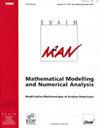Layer-averaged approximation of Navier-Stokes system with complex rheologies
IF 1.9
3区 数学
Q2 Mathematics
Esaim-Mathematical Modelling and Numerical Analysis-Modelisation Mathematique et Analyse Numerique
Pub Date : 2023-07-30
DOI:10.1051/m2an/2023065
引用次数: 0
Abstract
In this work, we present a family of layer-averaged models for the Navier-Stokes equations. For its derivation, we consider a layerwise linear vertical profile for the horizontal velocity component. As a particular case, we also obtain layer-averaged models with the common layerwise constant approximation of the horizontal velocity. The approximation of the derivatives of the velocity components is set by following the theory of distributions to account for the discontinuities at the internal interfaces. Several models has been proposed, depending on the order of approximation of an asymptotic analysis respect to the shallowness parameter. Then, we obtain a hydrostatic model with vertical viscous effects, a hydrostatic model where the pressure depends on the stress tensor, and fully non-hydrostatic models, with a complex rheology. It is remarkable that the proposed models generalize plenty of previous models in the literature. Furthermore, all of them satisfy an exact dissipative energy balance. We also propose a model that is second-order accurate in the vertical direction thanks to a correction of the shear stress approximation. Finally, we show how effective the layerwise linear approach is to notably improve, with respect to the layerwise constant method, the approximation of the velocity profile for some geophysical flows. Namely, a Newtonian fluid and some complex viscoplastic (dry granular and Herschel-Bulkley) materials are considered.具有复杂流变性的Navier-Stokes系统的层平均近似
在这项工作中,我们提出了一组Navier-Stokes方程的层平均模型。对于其推导,我们考虑水平速度分量的分层线性垂直剖面。作为一种特殊情况,我们还得到了层平均模型,该模型具有常见的水平速度逐层常数近似。速度分量导数的近似是通过遵循分布理论来设定的,以解释内部界面的不连续。根据关于浅度参数的渐近分析的近似阶数,提出了几种模型。然后,我们得到了一个具有垂直粘性效应的流体静力模型,一个压力取决于应力张量的流体静力模型,以及一个具有复杂流变学的完全非流体静力模型。值得注意的是,所提出的模型推广了文献中大量以前的模型。此外,它们都满足精确的耗散能量平衡。我们还提出了一个在垂直方向上二阶精确的模型,这要感谢对剪应力近似的修正。最后,我们展示了分层线性方法是如何有效地显著改善,相对于分层常数法,一些地球物理流动的速度剖面的近似。即,牛顿流体和一些复杂的粘塑性(干颗粒和赫歇尔-巴克利)材料被考虑。
本文章由计算机程序翻译,如有差异,请以英文原文为准。
求助全文
约1分钟内获得全文
求助全文
来源期刊

CiteScore
2.70
自引率
5.30%
发文量
27
审稿时长
6-12 weeks
期刊介绍:
M2AN publishes original research papers of high scientific quality in two areas: Mathematical Modelling, and Numerical Analysis. Mathematical Modelling comprises the development and study of a mathematical formulation of a problem. Numerical Analysis comprises the formulation and study of a numerical approximation or solution approach to a mathematically formulated problem.
Papers should be of interest to researchers and practitioners that value both rigorous theoretical analysis and solid evidence of computational relevance.
 求助内容:
求助内容: 应助结果提醒方式:
应助结果提醒方式:


